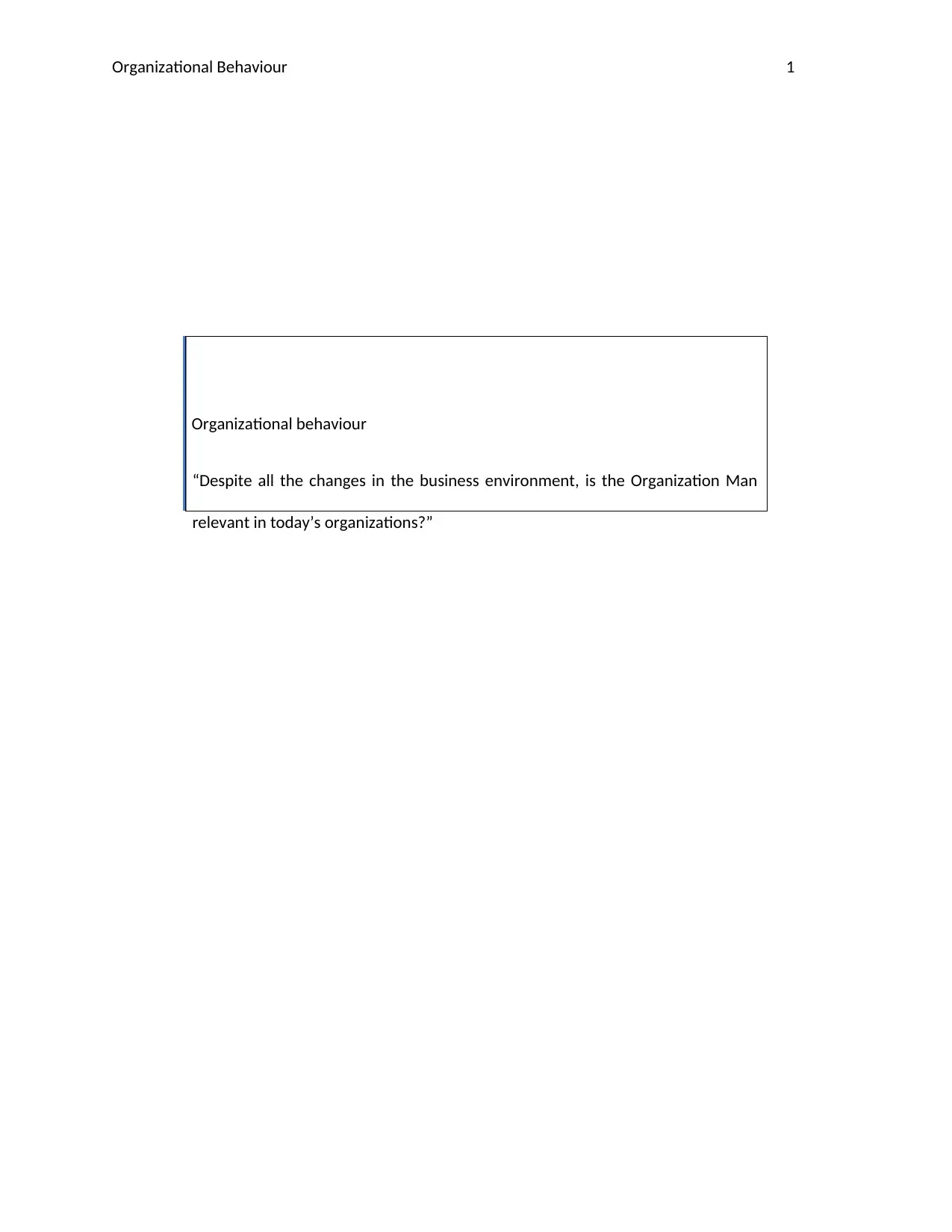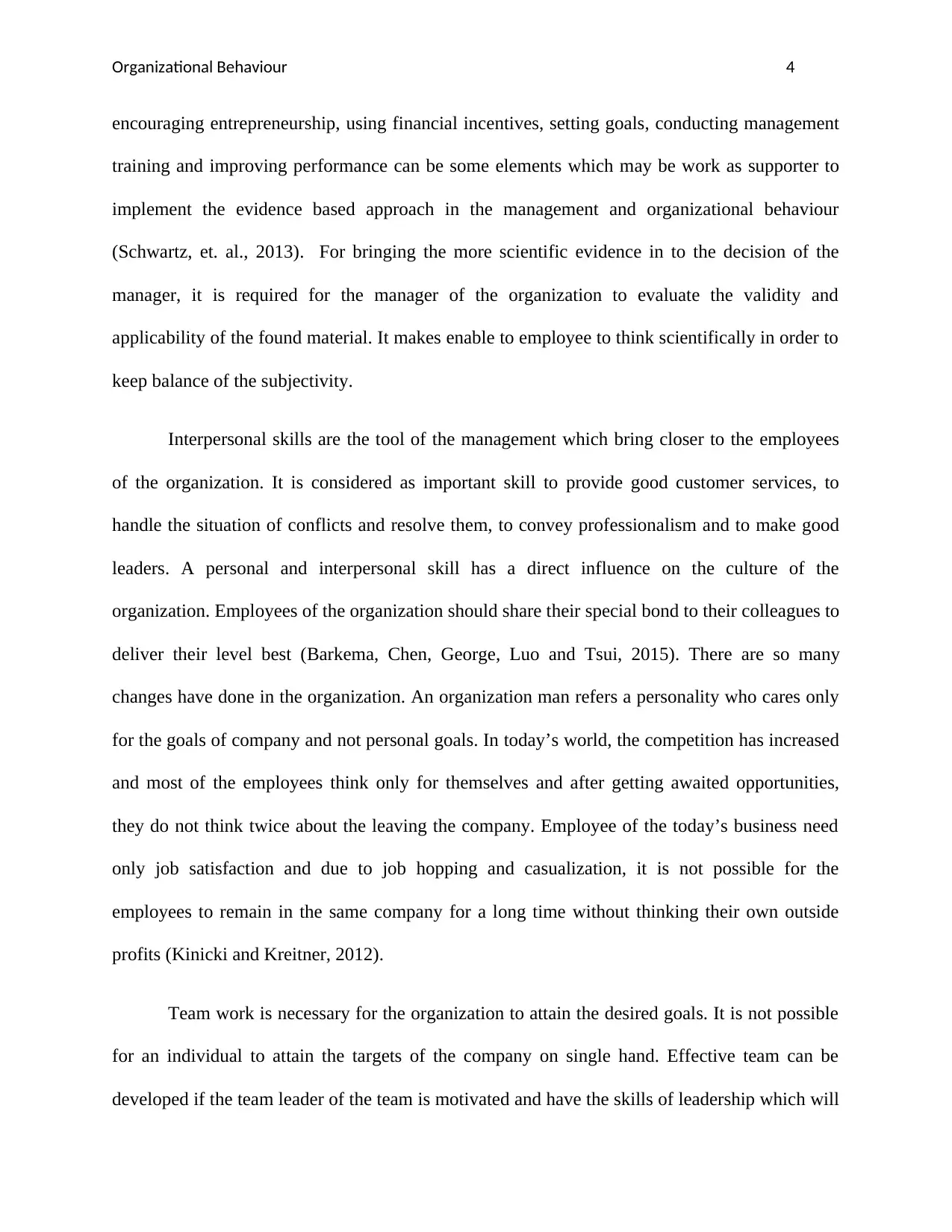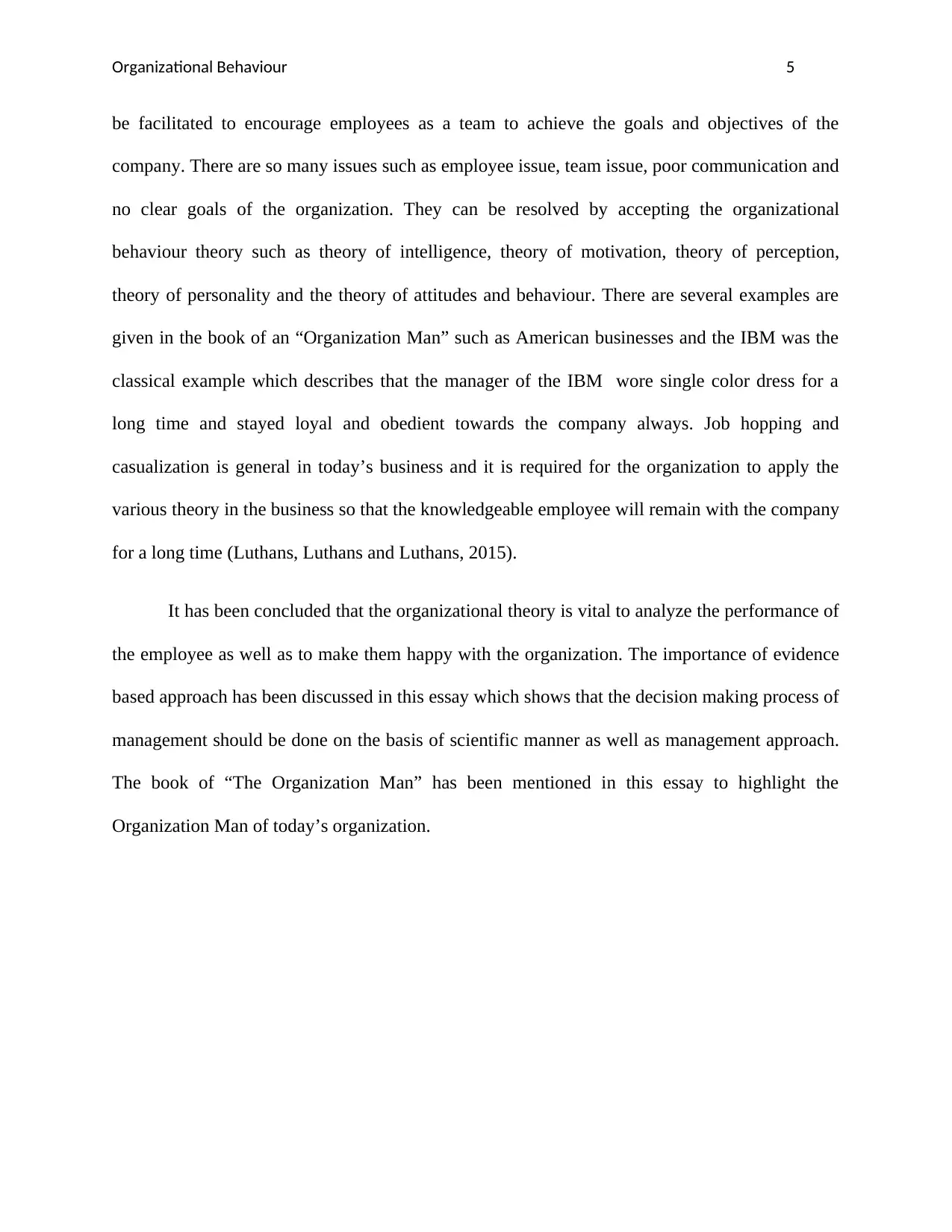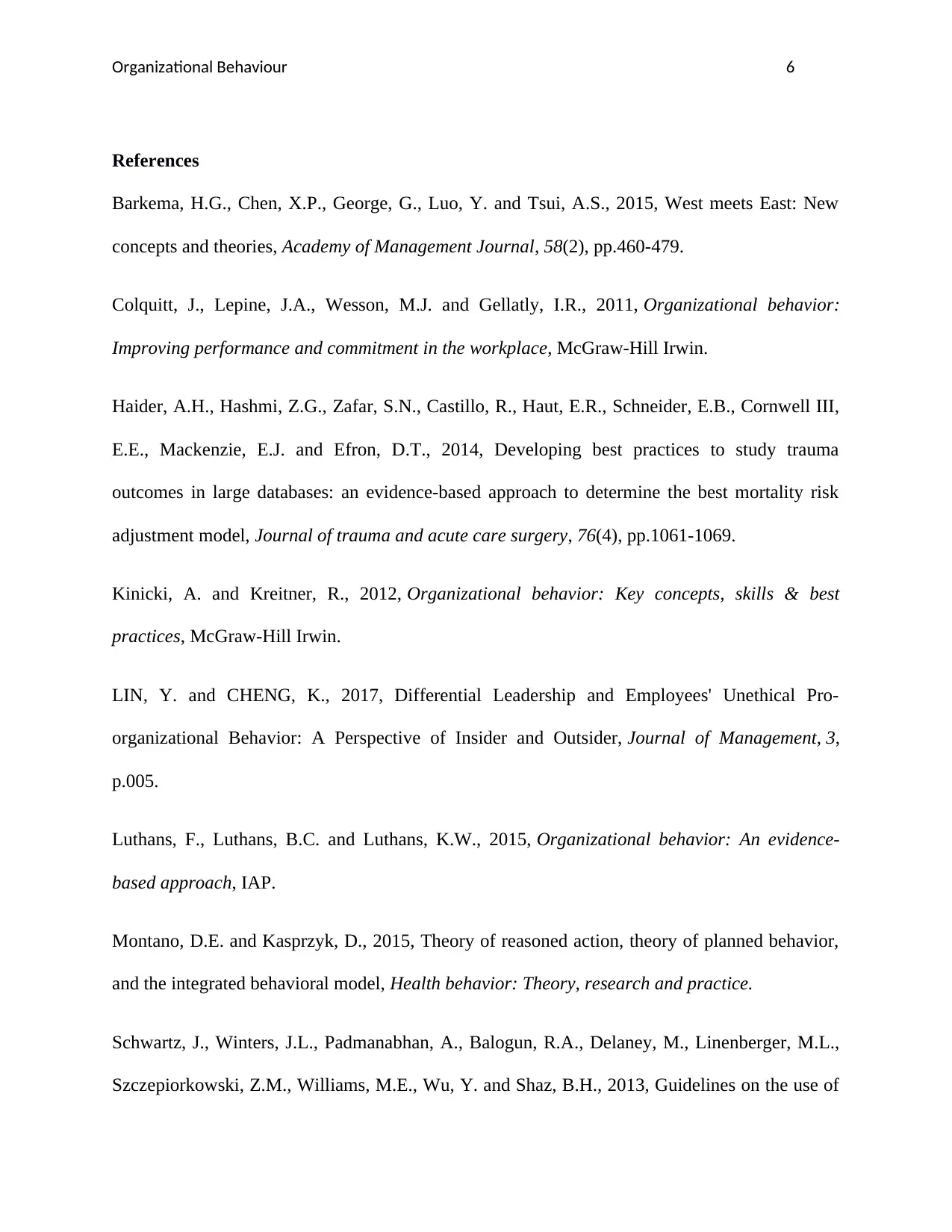Organizational Behaviour Essay: Is Organization Man Relevant Today?
VerifiedAdded on 2020/03/23
|7
|1697
|57
Essay
AI Summary
This essay delves into the field of organizational behaviour, critically assessing the relevance of the 'Organization Man' concept in contemporary business environments. It explores various organizational behaviour theories, including expectancy, equity, attribution, goal-setting, and reinforcement theories, and their impact on employee motivation and job satisfaction. The essay highlights different types of employee behaviours, such as task performers, organizational citizens, and those exhibiting counterproductive behaviours. It also discusses the importance of evidence-based approaches in managerial decision-making, emphasizing the need for scientific evaluation and interpersonal skills within organizations. The essay contrasts the traditional 'Organization Man' with the modern employee's focus on job satisfaction and the significance of teamwork, while also addressing issues such as employee turnover and the application of organizational behaviour theories to resolve workplace challenges. The conclusion reinforces the value of organizational theory in analyzing employee performance and the importance of adopting scientific management approaches.

Organizational Behaviour 1
Organizational behaviour
“Despite all the changes in the business environment, is the Organization Man
relevant in today’s organizations?”
Organizational behaviour
“Despite all the changes in the business environment, is the Organization Man
relevant in today’s organizations?”
Paraphrase This Document
Need a fresh take? Get an instant paraphrase of this document with our AI Paraphraser

Organizational Behaviour 2
Organizational behaviour is the application or study which execute within the business to
know that how people will act with others. It is considered as the human tool for the benefits of
human. It keeps huge importance in the business because due to OB, both managers and
employees come to know that what people behave the way they do. It has several theories which
will be helpful to enhance the productivity of the employee and the job satisfaction. This essay
will reflect the discussion about the relevancy of the organization man in today’s business.
There are several contemporary theories and concepts of organizational behaviour.
Expectancy theory, equity theory, attribution theory, goal-setting theory and reinforcement
theory are some theories which can be used to motivate employees to accomplish the work. In
the book of the organization man, a key point was made that people became convinced that in
comparison of an individual, group could take better decision (Colquitt, Lepine, Wesson, and
Gellatly, 2011). The base of equity theory is based on assumption that people want to be treated
fairly. Attribution theory refers to the process and responsibilities based on which people
interpret the cause of their behaviors to others. Goal setting theory defines that if goal and
objective of the organization is established for an individual, the employee of the company will
be motivated to achieve them. It is the theory which enhances the productivity of those
employees who are having challenging task in comparison of easy task. Reinforcement theory
consists with positive and negative reinforcement as well as punishment and extinction. Positive
reinforcement gives preference to the reward for the desirable response (Haider, et. al., 2014).
Negative reinforcement refers the behaviour of the employee to avoid undesirable results.
Punishment is being given for the mistake to the employee by the manager. Extinction refers to
remove all reinforcements in result of an inadequate behaviour. The theory of reinforcing
Organizational behaviour is the application or study which execute within the business to
know that how people will act with others. It is considered as the human tool for the benefits of
human. It keeps huge importance in the business because due to OB, both managers and
employees come to know that what people behave the way they do. It has several theories which
will be helpful to enhance the productivity of the employee and the job satisfaction. This essay
will reflect the discussion about the relevancy of the organization man in today’s business.
There are several contemporary theories and concepts of organizational behaviour.
Expectancy theory, equity theory, attribution theory, goal-setting theory and reinforcement
theory are some theories which can be used to motivate employees to accomplish the work. In
the book of the organization man, a key point was made that people became convinced that in
comparison of an individual, group could take better decision (Colquitt, Lepine, Wesson, and
Gellatly, 2011). The base of equity theory is based on assumption that people want to be treated
fairly. Attribution theory refers to the process and responsibilities based on which people
interpret the cause of their behaviors to others. Goal setting theory defines that if goal and
objective of the organization is established for an individual, the employee of the company will
be motivated to achieve them. It is the theory which enhances the productivity of those
employees who are having challenging task in comparison of easy task. Reinforcement theory
consists with positive and negative reinforcement as well as punishment and extinction. Positive
reinforcement gives preference to the reward for the desirable response (Haider, et. al., 2014).
Negative reinforcement refers the behaviour of the employee to avoid undesirable results.
Punishment is being given for the mistake to the employee by the manager. Extinction refers to
remove all reinforcements in result of an inadequate behaviour. The theory of reinforcing

Organizational Behaviour 3
behaviour should be applied after the analyzing the situations which leads to the aspiration
outcomes.
There are various kinds of human works in the organization who will have different
natures. They can be task performer, organizational citizenship, counterproductive work
behaviour and the person who has the nature of joining and staying with the organization. Task
performers have the nature of setting thee goals and achieve them within time frame. They are
very constructive towards their work and focused on the accomplishment of task. The people
who have the nature of organizational citizenship are able to handle the team in effective manner
and enhance the cooperation between the employees (Lin and Cheng, 2017). An employee with
counterproductive behaviour will definitely have a tendency to harm the organization. The job
satisfied employee will stay with the organization for a long time and this kind of nature is very
helpful for the organization to maintain the reputation in the view of outsiders. The book of an
organization man was deeply examined of the concept of loyalty within the organization. It
defines that the evidence based approach is an effective approach to make decision on the basis
of managerial. Evidence based approach includes complex and conscientious decision making. It
is based on the characters, situation and patience. It is considered as a philosophical approach. It
is important for the management because it is an emerging movement to unambiguously utilize
present based practices in the context of managerial decision making (Montano and Kasprzyk,
2015).
Evidence based approach can be implemented in the business by involving number of
employees in the decision making. The aim of this approach is to link the gap between scientific
research and management practices. This approach can be promoted in the management by
consultation and education. Along with that by motivating the employees, managing mergers,
behaviour should be applied after the analyzing the situations which leads to the aspiration
outcomes.
There are various kinds of human works in the organization who will have different
natures. They can be task performer, organizational citizenship, counterproductive work
behaviour and the person who has the nature of joining and staying with the organization. Task
performers have the nature of setting thee goals and achieve them within time frame. They are
very constructive towards their work and focused on the accomplishment of task. The people
who have the nature of organizational citizenship are able to handle the team in effective manner
and enhance the cooperation between the employees (Lin and Cheng, 2017). An employee with
counterproductive behaviour will definitely have a tendency to harm the organization. The job
satisfied employee will stay with the organization for a long time and this kind of nature is very
helpful for the organization to maintain the reputation in the view of outsiders. The book of an
organization man was deeply examined of the concept of loyalty within the organization. It
defines that the evidence based approach is an effective approach to make decision on the basis
of managerial. Evidence based approach includes complex and conscientious decision making. It
is based on the characters, situation and patience. It is considered as a philosophical approach. It
is important for the management because it is an emerging movement to unambiguously utilize
present based practices in the context of managerial decision making (Montano and Kasprzyk,
2015).
Evidence based approach can be implemented in the business by involving number of
employees in the decision making. The aim of this approach is to link the gap between scientific
research and management practices. This approach can be promoted in the management by
consultation and education. Along with that by motivating the employees, managing mergers,
⊘ This is a preview!⊘
Do you want full access?
Subscribe today to unlock all pages.

Trusted by 1+ million students worldwide

Organizational Behaviour 4
encouraging entrepreneurship, using financial incentives, setting goals, conducting management
training and improving performance can be some elements which may be work as supporter to
implement the evidence based approach in the management and organizational behaviour
(Schwartz, et. al., 2013). For bringing the more scientific evidence in to the decision of the
manager, it is required for the manager of the organization to evaluate the validity and
applicability of the found material. It makes enable to employee to think scientifically in order to
keep balance of the subjectivity.
Interpersonal skills are the tool of the management which bring closer to the employees
of the organization. It is considered as important skill to provide good customer services, to
handle the situation of conflicts and resolve them, to convey professionalism and to make good
leaders. A personal and interpersonal skill has a direct influence on the culture of the
organization. Employees of the organization should share their special bond to their colleagues to
deliver their level best (Barkema, Chen, George, Luo and Tsui, 2015). There are so many
changes have done in the organization. An organization man refers a personality who cares only
for the goals of company and not personal goals. In today’s world, the competition has increased
and most of the employees think only for themselves and after getting awaited opportunities,
they do not think twice about the leaving the company. Employee of the today’s business need
only job satisfaction and due to job hopping and casualization, it is not possible for the
employees to remain in the same company for a long time without thinking their own outside
profits (Kinicki and Kreitner, 2012).
Team work is necessary for the organization to attain the desired goals. It is not possible
for an individual to attain the targets of the company on single hand. Effective team can be
developed if the team leader of the team is motivated and have the skills of leadership which will
encouraging entrepreneurship, using financial incentives, setting goals, conducting management
training and improving performance can be some elements which may be work as supporter to
implement the evidence based approach in the management and organizational behaviour
(Schwartz, et. al., 2013). For bringing the more scientific evidence in to the decision of the
manager, it is required for the manager of the organization to evaluate the validity and
applicability of the found material. It makes enable to employee to think scientifically in order to
keep balance of the subjectivity.
Interpersonal skills are the tool of the management which bring closer to the employees
of the organization. It is considered as important skill to provide good customer services, to
handle the situation of conflicts and resolve them, to convey professionalism and to make good
leaders. A personal and interpersonal skill has a direct influence on the culture of the
organization. Employees of the organization should share their special bond to their colleagues to
deliver their level best (Barkema, Chen, George, Luo and Tsui, 2015). There are so many
changes have done in the organization. An organization man refers a personality who cares only
for the goals of company and not personal goals. In today’s world, the competition has increased
and most of the employees think only for themselves and after getting awaited opportunities,
they do not think twice about the leaving the company. Employee of the today’s business need
only job satisfaction and due to job hopping and casualization, it is not possible for the
employees to remain in the same company for a long time without thinking their own outside
profits (Kinicki and Kreitner, 2012).
Team work is necessary for the organization to attain the desired goals. It is not possible
for an individual to attain the targets of the company on single hand. Effective team can be
developed if the team leader of the team is motivated and have the skills of leadership which will
Paraphrase This Document
Need a fresh take? Get an instant paraphrase of this document with our AI Paraphraser

Organizational Behaviour 5
be facilitated to encourage employees as a team to achieve the goals and objectives of the
company. There are so many issues such as employee issue, team issue, poor communication and
no clear goals of the organization. They can be resolved by accepting the organizational
behaviour theory such as theory of intelligence, theory of motivation, theory of perception,
theory of personality and the theory of attitudes and behaviour. There are several examples are
given in the book of an “Organization Man” such as American businesses and the IBM was the
classical example which describes that the manager of the IBM wore single color dress for a
long time and stayed loyal and obedient towards the company always. Job hopping and
casualization is general in today’s business and it is required for the organization to apply the
various theory in the business so that the knowledgeable employee will remain with the company
for a long time (Luthans, Luthans and Luthans, 2015).
It has been concluded that the organizational theory is vital to analyze the performance of
the employee as well as to make them happy with the organization. The importance of evidence
based approach has been discussed in this essay which shows that the decision making process of
management should be done on the basis of scientific manner as well as management approach.
The book of “The Organization Man” has been mentioned in this essay to highlight the
Organization Man of today’s organization.
be facilitated to encourage employees as a team to achieve the goals and objectives of the
company. There are so many issues such as employee issue, team issue, poor communication and
no clear goals of the organization. They can be resolved by accepting the organizational
behaviour theory such as theory of intelligence, theory of motivation, theory of perception,
theory of personality and the theory of attitudes and behaviour. There are several examples are
given in the book of an “Organization Man” such as American businesses and the IBM was the
classical example which describes that the manager of the IBM wore single color dress for a
long time and stayed loyal and obedient towards the company always. Job hopping and
casualization is general in today’s business and it is required for the organization to apply the
various theory in the business so that the knowledgeable employee will remain with the company
for a long time (Luthans, Luthans and Luthans, 2015).
It has been concluded that the organizational theory is vital to analyze the performance of
the employee as well as to make them happy with the organization. The importance of evidence
based approach has been discussed in this essay which shows that the decision making process of
management should be done on the basis of scientific manner as well as management approach.
The book of “The Organization Man” has been mentioned in this essay to highlight the
Organization Man of today’s organization.

Organizational Behaviour 6
References
Barkema, H.G., Chen, X.P., George, G., Luo, Y. and Tsui, A.S., 2015, West meets East: New
concepts and theories, Academy of Management Journal, 58(2), pp.460-479.
Colquitt, J., Lepine, J.A., Wesson, M.J. and Gellatly, I.R., 2011, Organizational behavior:
Improving performance and commitment in the workplace, McGraw-Hill Irwin.
Haider, A.H., Hashmi, Z.G., Zafar, S.N., Castillo, R., Haut, E.R., Schneider, E.B., Cornwell III,
E.E., Mackenzie, E.J. and Efron, D.T., 2014, Developing best practices to study trauma
outcomes in large databases: an evidence-based approach to determine the best mortality risk
adjustment model, Journal of trauma and acute care surgery, 76(4), pp.1061-1069.
Kinicki, A. and Kreitner, R., 2012, Organizational behavior: Key concepts, skills & best
practices, McGraw-Hill Irwin.
LIN, Y. and CHENG, K., 2017, Differential Leadership and Employees' Unethical Pro-
organizational Behavior: A Perspective of Insider and Outsider, Journal of Management, 3,
p.005.
Luthans, F., Luthans, B.C. and Luthans, K.W., 2015, Organizational behavior: An evidence-
based approach, IAP.
Montano, D.E. and Kasprzyk, D., 2015, Theory of reasoned action, theory of planned behavior,
and the integrated behavioral model, Health behavior: Theory, research and practice.
Schwartz, J., Winters, J.L., Padmanabhan, A., Balogun, R.A., Delaney, M., Linenberger, M.L.,
Szczepiorkowski, Z.M., Williams, M.E., Wu, Y. and Shaz, B.H., 2013, Guidelines on the use of
References
Barkema, H.G., Chen, X.P., George, G., Luo, Y. and Tsui, A.S., 2015, West meets East: New
concepts and theories, Academy of Management Journal, 58(2), pp.460-479.
Colquitt, J., Lepine, J.A., Wesson, M.J. and Gellatly, I.R., 2011, Organizational behavior:
Improving performance and commitment in the workplace, McGraw-Hill Irwin.
Haider, A.H., Hashmi, Z.G., Zafar, S.N., Castillo, R., Haut, E.R., Schneider, E.B., Cornwell III,
E.E., Mackenzie, E.J. and Efron, D.T., 2014, Developing best practices to study trauma
outcomes in large databases: an evidence-based approach to determine the best mortality risk
adjustment model, Journal of trauma and acute care surgery, 76(4), pp.1061-1069.
Kinicki, A. and Kreitner, R., 2012, Organizational behavior: Key concepts, skills & best
practices, McGraw-Hill Irwin.
LIN, Y. and CHENG, K., 2017, Differential Leadership and Employees' Unethical Pro-
organizational Behavior: A Perspective of Insider and Outsider, Journal of Management, 3,
p.005.
Luthans, F., Luthans, B.C. and Luthans, K.W., 2015, Organizational behavior: An evidence-
based approach, IAP.
Montano, D.E. and Kasprzyk, D., 2015, Theory of reasoned action, theory of planned behavior,
and the integrated behavioral model, Health behavior: Theory, research and practice.
Schwartz, J., Winters, J.L., Padmanabhan, A., Balogun, R.A., Delaney, M., Linenberger, M.L.,
Szczepiorkowski, Z.M., Williams, M.E., Wu, Y. and Shaz, B.H., 2013, Guidelines on the use of
⊘ This is a preview!⊘
Do you want full access?
Subscribe today to unlock all pages.

Trusted by 1+ million students worldwide

Organizational Behaviour 7
therapeutic apheresis in clinical practice—evidence‐based approach from the Writing Committee
of the American Society for Apheresis: the sixth special issue, Journal of clinical
apheresis, 28(3), pp.145-284.
therapeutic apheresis in clinical practice—evidence‐based approach from the Writing Committee
of the American Society for Apheresis: the sixth special issue, Journal of clinical
apheresis, 28(3), pp.145-284.
1 out of 7
Related Documents
Your All-in-One AI-Powered Toolkit for Academic Success.
+13062052269
info@desklib.com
Available 24*7 on WhatsApp / Email
![[object Object]](/_next/static/media/star-bottom.7253800d.svg)
Unlock your academic potential
Copyright © 2020–2025 A2Z Services. All Rights Reserved. Developed and managed by ZUCOL.




